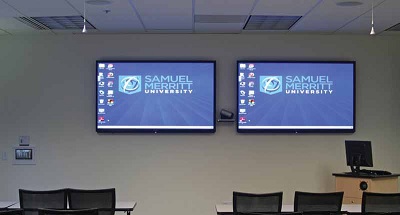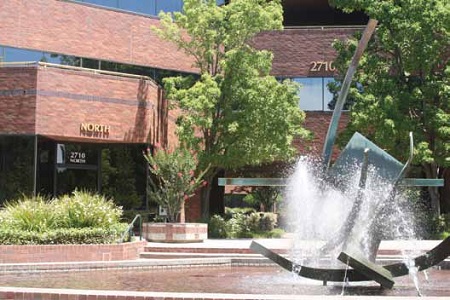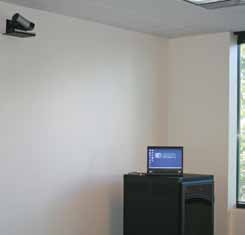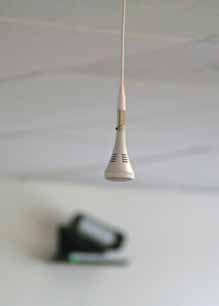Samuel Merritt University Mixes Online & Traditional Education

Classroom-style distance learning setup used in Sacramento. Note the Vaddio camera mounted between the dual displays and the docking AMX touch panel mounted on the wall. It’s a real dilemma. While graduate students have the most to gain from face-to-face interactions with fellow students, they are the most likely to opt for online classes, given that many are older, have established families and must work while they go to school.
Undergraduates, who are more likely to leave home to attend school on campus, miss out on the diverse, regional points of view that online students gain. That’s especially true in healthcare education, where the differences between rural and urban setting can be significant.
One way to bridge the gap, according to Blair Simmons, director of Information Technology Services for Samuel Merritt University, is to add two-way video conferencing to both traditional and online offerings. At Samuel Merritt, undergraduate nursing students interact with counterparts at other campuses via Cisco-based video conferencing rooms, while online doctoral students have the chance to see and talk to each other via WebEx or Lync “virtual classrooms.”
Although Samuel Merritt University has used video conferencing technology since 2005, they’ve been working with the Bay Area office of CompView Audio Visual to upgrade their room-based systems. According to Simmons, they are gaining three crucial benefits: high definition video, greatly improved audio and the ability to connect key instructors into video calls via their own laptops.
Traditional versus video classrooms

Outside the Samuel Merritt classroom building at a satellite campus in Sacramento Samuel Merritt is a private university based in Oakland, California, offering undergraduate degrees in nursing and graduate degrees in nursing, physical therapy, physician assistant, occupational therapy and podiatric medicine. In offering the undergraduate programs, Samuel Merritt utilizes lecture/discussion classes, laboratory classes using patient simulators, and clinical placements. Graduate classes usually follow a seminar format, whether online or campus-based.
Recently, CompView Audio Visual upgraded video conferencing rooms at the Samuel Merritt campuses in Sacramento and San Mateo, with plans to upgrade a third in Oakland.
A daily selection of features, industry news, and analysis for tech managers. Sign up below.
In San Mateo, CompView upgraded a boardroom- style conference room, which the university uses mainly for staff meetings, including monthly faculty conferences. From time to time, they also use the room, which has seating for 30, as a distance-learning classroom.
In Sacramento, CompView upgraded a traditionally styled 48-seat classroom, to be used mainly for lecture/discussion nursing classes as well as regular faculty meetings.
In Oakland, CompView will soon upgrade another traditional classroom for lecture/discussion classes and faculty meetings.

Conference-style setup used in San Mateo. Note v-shaped table, which allows front camera to capture everyone without obstruction. Simmons says the meeting function is crucial to the nursing program. “Regular collaborative sessions among the nursing faculty and staff members at the three campuses derive tremendous benefits in assuring balance in the curriculum and consistency in serving our students.” Yet with the video conferencing systems, there’s no need to ask instructors to undertake the two-hour drive from Sacramento to Oakland, or even the 40-minute drive from San Mateo.
In the same way, the conferencing systems allow instructors to lead sessions in Sacramento from the classroom in Oakland, without the need for driving time or for additional instructors. “It’s a better use of resources,” Simmons explains.
The main benefit, however, comes from the chance to interact with students from a different city. “Although these are all urban areas, students have a chance to see different attitudes toward medicine and clinical practice, given the different size and socioeconomic conditions in each location. Even in these three areas of California, the nuances in perspective can really add depth to the discussion,” says Simmons.
In addition, students in Oakland connect to lectures organized by the Kaiser Permanente healthcare consortium, along with several other universities, further widening their perspective. Key instructors and administrators can connect from their laptops using the Cisco Jabber client.

Equipment rack and camera mounted in rear of classroom in Sacramento Students and instructors in Samuel Merritt’s Doctor of Nursing Practice program, which is offered exclusively online, connect their laptops and webcams for four virtual sessions each spring using the WebEx service. “This is a great addition to the doctoral classes,” Simmons explains. “At this level the classes are predominantly dialog driven, with the students and instructors acting as peers. Previous online courses had been conducted in an asynchronous setting, through blogs, discussion boards and email. There are interactive aspects of learning which you can’t capture in that way.”
What you lose in a purely online class is the spontaneity of a live discussion and the subtle communication that takes place through body language, vocal tones and facial expressions — the sum of which Simmons calls ‘social presence.’ The WebEx connection allows students and instructors to see each other and speak together in real time.
In the same way, the classroom video conferencing connections allow instructors and students to see and interact with each other from different cities. Social presence is the goal here as well, and enhancing it is the main reason Samuel Merritt is upgrading its video conferencing systems. “High definition makes a huge difference,” Simmons explains. “The improved systems really bring people closer together. The experience is more realistic; understanding is improved. It’s amazing how much body language complements dialog.”
The technology upgrade
Alan Bender, account executive, says the CompView team worked very hard to maximize not only the video, but the audio quality of the new rooms.
To optimize the video, the CompView team based the conferencing systems on Cisco C40 codecs, which provide full 1080p high-definition over an IP network connection. At the front of each room are two 70” diagonal Sharp flat-panel displays, also offering 1080p resolution. “Normally they’ll use one display for far-end images and the other for supporting visuals, whether PowerPoint, video, or computer images,” Bender adds.

ClearOne Ceiling Microphone Array installed in Sacramento Between the displays, CompView mounted a Cisco 1080p pan-tilt-zoom camera to capture images of the students. On the back wall is an additional Cisco PTZ camera to capture images of the instructor.
To optimize the audio, the team included a Biamp Nexia TC processor, which handles microphone mixing, graphic equalization, filtering, and the echo cancellation that’s critical to a room-to-room call. The Nexia allowed the CompView team to tune each room in much the same way they would tune a concert hall, adjusting the frequency by frequency performance of the microphones and ceiling speakers to maximize speech intelligibility. “We no longer have a lot of ‘oh, what did you say’ exchanges,” Simmons says. “People speak in a normal tone of voice and it’s very easy to understand them.”
In the room in San Mateo the team installed hard-wired Shure boundary microphones on the boardroom-style table, which is shaped like a ‘V’ to allow the front camera unobstructed views of all who are seated there. They also included a wireless mic system with hand-held and lavalieres for the presenter’s use. “It’s always easier to get good pickup if you put the microphones close to the people talking,” Bender explains.
In Sacramento, however, they did not have that option, since the tables can be moved according to the needs of the class. Instead, they used the new ClearOne Ceiling Microphone Array. “These ClearOne arrays do a great job,” Bender says. Each hangs just over the heads of the students and includes three unidirectional microphone elements arranged to provide full 360-degree coverage. CompView used just four for the entire room, and the sound quality is virtually identical to the table mics.
Marcus Walton, Information Technology Services manager for Samuel Merritt University, says: “Students are able to collaborate anywhere within the classroom, with no limitations. The sound system provides the flexibility to speak freely.”
One small touch adds a lot of utility to the room in San Mateo. “Because of the way the room is configured, we had to mount the displays on a window wall,” Bender explains. “Of course it’s easy enough to add shading so that people can see the monitors without the sun in their eyes, but we couldn’t use standard monitor mounts. Fortunately Premier makes a pendant-style mount, the ECM-3763S, that we could secure into the framework above the ceiling. We like Premier because it’s a good, reliable mount that we can depend on, and there’s a lot of flexibility in their product line for when we run into an unusual situation.”
Simmons says that as great as all of this technology is, it’s crucial that users have support at all times. “The instructors do not want to have to be technicians; they just want to focus on their presentations,” he says.
For that reason CompView designed the systems to be as easy to use as possible, and they helped set up the IT department to remotely monitor each room and be able to step in and help as needed.

Conference-style setup in San Mateo. Note front camera mounted between displays AMX touch screens in each room give instructors highly visual, step by step operating menus for every system, from the volume levels to camera controls. For video calls, the system connects automatically without instructor input. “We add each class to the schedule and, on that date and time, the systems turn themselves on and make the connection. They’re ready when the instructors and students walk into the classrooms,” says Simmons.
Given the possibilities for error, the IT department monitors each video class and can monitor local uses of the AV systems as well. “The nice thing about it,” Bender explains, “is that they don’t need to leave the IT office. A technician can open a window for each classroom on his PC workstation and see the AMX controls, the video windows, and he can monitor the audio. They normally keep these windows open during video calls yet can do other work unless there’s a problem.”
Walton says problems are few. “The faculty and staff love the new rooms and their AV systems. With distance learning initiatives growing, the preference to use these rooms will be great. Currently we have a waiting list to use them.”
Don Kreski is the president of Kreski Associates.
Bringing IT All Together
Cisco Prime Collaboration gives IT a single unified management console from which to manage the vast majority of Cisco collaboration products — from it they can deploy servers, provision devices from the phones on users’ desks to the Jabber clients on their laptops, and provide general feature management and service assurance. Additionally, with the emergence of BYOD (Bring Your Own Device) within the workplace, Prime Collaboration allows IT to give users permission to easily add their own devices to the system – phones, tablets, etc. This helps employees to get connected faster and drives more meaningful communications. Rowan Trollope, SVP/GM, Collaboration Technology Group, Cisco, said: “The rise in mobility has opened up new ways in which teams, employees and customers are choosing to connect and collaborate with one another to get things done. The key to success in this new world is having open and accessible communications that cross experiences — whether it be in a physical office, face-to- face through a video call, in a voice call, or in a converged connection through Cisco Jabber.” Source: thenetwork.cisco.com
Technology Used
- AMX controls
- Biamp Nexia TC processor
- Cisco 1080p pan-tilt-zoom camera
- ClearOne Ceiling Microphone Array
- WebEx
- Premier Mounts’ ECM-3763S Ceiling Mount used hang two 70-inch monitors against the window wall
- Shure boundary microphones (hard-wired)
The University of Michigan Solar Car Team Leverages Flexible Wireless Audio Conferencing Solution to Design Solar Car
Challenge
The University of Michigan Solar Car Team is a student-run organization that designs, builds, and races solar electric vehicles at national and international events. Established in 1989, the team has built several award-winning vehicles and is recognized as the most successful solar car team in North America. To prepare for the upcoming World Solar Challenge in Darwin, Australia, the group’s engineering, business, strategy, and operations divisions needed a conferencing solution that would enable effective communication with sponsors, potential sponsors, vendors, and advisers in addition to discussing specific virtual design issues of Generation, its new solar car.
While the team held most of its preparatory meetings onsite, the group needed to meet with advisers and supporters located in different parts of the country. Since sponsors, vendors, and advisers are critical to the crew, the University of Michigan Solar Car Team required a conferencing solution what would enable the highest possible audio quality in order to adequately hear its stakeholders over calls. This would avoid problems related to ordering the wrong parts, misunderstanding timelines, or miscommunicating with the university’s past solar car builders, which would result in the loss of valuable tips and information. With calls taking place on a daily basis, the solution also needed to be simple to set up, easy to use, and able to function with a variety of peripherals such as personal computers and cell phones.
Solution
This past May, University of Michigan Solar Car Team began using Revolabs’ FLX wireless conference phone, resulting in the immediate upgrading of their conferencing capabilities. With wireless operation, high-quality wideband audio, and integrated Bluetooth® capabilities, the solution gives the team access to augmented audio and the freedom to place speakers, microphones, and the dial pad anywhere in the meeting room.
